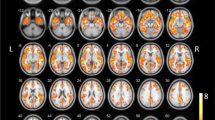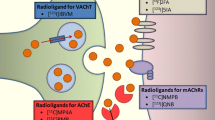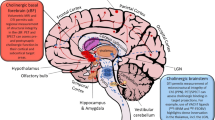Abstract
Purpose
Molecular imaging agents targeting butyrylcholinesterase (BChE) have shown promise in other neurodegenerative disorders and may have utility in detecting changes to normal appearing white matter in multiple sclerosis (MS). BChE activity is present in white matter and localizes to activated microglia associated with MS lesions. The purpose of this study was to further characterize changes in the cholinergic system in MS pathology, and to explore the utility of BChE radioligands as potential diagnostic and treatment monitoring agents in MS.
Procedure
Cortical and white matter lesions were identified using myelin staining, and lesions were classified based on microglial activation patterns. Adjacent brain sections were used for cholinesterase histochemistry and in vitro autoradiography using phenyl 4-[123I]-iodophenylcarbamate (123I-PIP), a previously described small-molecule cholinesterase-binding radioligand.
Results
BChE activity is positively correlated with microglial activation in white matter MS lesions. There is no alteration in cholinesterase activity in cortical MS lesions. 123I-PIP autoradiography revealed uptake of radioactivity in normal white matter, absence of radioactivity within demyelinated MS lesions, and variable uptake of radioactivity in adjacent normal-appearing white matter.
Conclusions
BChE imaging agents have the potential to detect MS lesions and subtle pathology in normal-appearing white matter in postmortem MS brain tissue. The possibility of BChE imaging agents serving to supplement current diagnostic and treatment monitoring strategies should be evaluated.







Similar content being viewed by others
References
Bö L, Mörk S, Kong PA, Nyland H, Pardo CA, Trapp BD (1994) Detection of MHC class II-antigens on macrophages and microglia, but not on astrocytes and endothelia in active multiple sclerosis lesions. J Neuroimmunol 51:135–146
Bitsch A, Schuchardt J, Bunkowski S et al (2000) Acute axonal injury in multiple sclerosis. Correlation with demyelination and inflammation. Brain J Neurol 123(Pt 6):1174–1183
Kutzelnigg A, Lucchinetti CF, Stadelmann C, Brück W, Rauschka H, Bergmann M, Schmidbauer M, Parisi JE, Lassmann H (2005) Cortical demyelination and diffuse white matter injury in multiple sclerosis. Brain J Neurol 128:2705–2712
Gold R, Linington C, Lassmann H (2006) Understanding pathogenesis and therapy of multiple sclerosis via animal models: 70 years of merits and culprits in experimental autoimmune encephalomyelitis research. Brain J Neurol 129:1953–1971
Sanabria-Castro A, Flores-Díaz M, Alape-Girón A (2019) Biological models in multiple sclerosis. J Neurosci Res 00:1–18
Brownlee WJ, Miller DH (2014) Clinically isolated syndromes and the relationship to multiple sclerosis. J Clin Neurosci 21:2065–2071
Eran A, García M, Malouf R, Bosak N, Wagner R, Ganelin-Cohen E, Artsy E, Shifrin A, Rozenberg A (2018) MRI in predicting conversion to multiple sclerosis within 1 year. Brain Behav 8:e01042
Lublin FD (2014) New multiple sclerosis phenotypic classification. Eur Neurol 72(Suppl 1):1–5
Filippi M, Rocca MA, Ciccarelli O, de Stefano N, Evangelou N, Kappos L, Rovira A, Sastre-Garriga J, Tintorè M, Frederiksen JL, Gasperini C, Palace J, Reich DS, Banwell B, Montalban X, Barkhof F, MAGNIMS Study Group (2016) MRI criteria for the diagnosis of multiple sclerosis: MAGNIMS consensus guidelines. Lancet Neurol 15:292–303
Thompson AJ, Banwell BL, Barkhof F, Carroll WM, Coetzee T, Comi G, Correale J, Fazekas F, Filippi M, Freedman MS, Fujihara K, Galetta SL, Hartung HP, Kappos L, Lublin FD, Marrie RA, Miller AE, Miller DH, Montalban X, Mowry EM, Sorensen PS, Tintoré M, Traboulsee AL, Trojano M, Uitdehaag BMJ, Vukusic S, Waubant E, Weinshenker BG, Reingold SC, Cohen JA (2018) Diagnosis of multiple sclerosis: 2017 revisions of the McDonald criteria. Lancet Neurol 17:162–173
Wattjes MP, Rovira À, Miller D, Yousry TA, Sormani MP, de Stefano MP, Tintoré M, Auger C, Tur C, Filippi M, Rocca MA, Fazekas F, Kappos L, Polman C, Frederik Barkhof, Xavier Montalban, MAGNIMS study group (2015) Evidence-based guidelines: MAGNIMS consensus guidelines on the use of MRI in multiple sclerosis—establishing disease prognosis and monitoring patients. Nat Rev Neurol 11:597–606
Traboulsee A, Simon JH, Stone L, Fisher E, Jones DE, Malhotra A, Newsome SD, Oh J, Reich DS, Richert N, Rammohan K, Khan O, Radue EW, Ford C, Halper J, Li D (2016) Revised recommendations of the Consortium of MS Centers Task Force for a standardized MRI protocol and clinical guidelines for the diagnosis and follow-up of multiple sclerosis. AJNR Am J Neuroradiol 37:394–401
Filippi M, Preziosa P, Meani A, Ciccarelli O, Mesaros S, Rovira A, Frederiksen J, Enzinger C, Barkhof F, Gasperini C, Brownlee W, Drulovic J, Montalban X, Cramer SP, Pichler A, Hagens M, Ruggieri S, Martinelli V, Miszkiel K, Tintorè M, Comi G, Dekker I, Uitdehaag B, Dujmovic-Basuroski I, Rocca MA (2018) Prediction of a multiple sclerosis diagnosis in patients with clinically isolated syndrome using the 2016 MAGNIMS and 2010 McDonald criteria: a retrospective study. Lancet Neurol 17:133–142
Gaetani L, Prosperini L, Mancini A, Eusebi P, Cerri MC, Pozzilli C, Calabresi P, Sarchielli P, di Filippo M (2018) 2017 revisions of McDonald criteria shorten the time to diagnosis of multiple sclerosis in clinically isolated syndromes. J Neurol 265:2684–2687
Filippi M (2015) MRI measures of neurodegeneration in multiple sclerosis: implications for disability, disease monitoring, and treatment. J Neurol 262:1–6
De Santis S, Granberg T, Ouellette R et al (2019) Evidence of early microstructural white matter abnormalities in multiple sclerosis from multi-shell diffusion MRI. NeuroImage Clin 22:101699
Silver A (1974) The biology of cholinesterases. North-Holland Pub. Co.; American Elsevier Pub. Co., Amsterdam; New York
Li B, Stribley JA, Ticu A, Xie W, Schopfer LM, Hammond P, Brimijoin S, Hinrichs SH, Lockridge O (2000) Abundant tissue butyrylcholinesterase and its possible function in the acetylcholinesterase knockout mouse. J Neurochem 75:1320–1331
Mesulam M-M, Guillozet A, Shaw P, Quinn B (2002) Widely spread butyrylcholinesterase can hydrolyze acetylcholine in the normal and Alzheimer brain. Neurobiol Dis 9:88–93
Mesulam MM (2009) Acetylcholine neurotransmission in CNS. In: Squire LR (ed) Encyclopedia of neuroscience. Academic Press, Oxford, pp 1–4
Mesulam M-M, Mufson EJ, Levey AI, Wainer BH (1983) Cholinergic innervation of cortex by the basal forebrain: cytochemistry and cortical connections of the septal area, diagonal band nuclei, nucleus basalis (Substantia innominata), and hypothalamus in the rhesus monkey. J Comp Neurol 214:170–197
Selden NR, Gitelman DR, Salamon-Murayama N et al (1998) Trajectories of cholinergic pathways within the cerebral hemispheres of the human brain. Brain J Neurol 121(Pt 12):2249–2257
Darvesh S, Grantham DL, Hopkins DA (1998) Distribution of butyrylcholinesterase in the human amygdala and hippocampal formation. J Comp Neurol 393:374–390
Darvesh S, Hopkins DA (2003) Differential distribution of butyrylcholinesterase and acetylcholinesterase in the human thalamus. J Comp Neurol 463:25–43
Darvesh S, Leblanc AM, Macdonald IR et al (2010) Butyrylcholinesterase activity in multiple sclerosis neuropathology. Chem Biol Interact 187:425–431
Guillozet AL, Smiley JF, Mash DC, Mesulam MM (1997) Butyrylcholinesterase in the life cycle of amyloid plaques. Ann Neurol 42:909–918
Darvesh S, Hopkins DA, Geula C (2003) Neurobiology of butyrylcholinesterase. Nat Rev Neurosci 4:131–138
Ballard CG, Greig NH, Guillozet-Bongaarts AL, Enz A, Darvesh S (2005) Cholinesterases: roles in the brain during health and disease. Curr Alzheimer Res 2:307–318
Darvesh S (2013) Butyrylcholinesterase radioligands to image Alzheimer’s disease brain. Chem Biol Interact 203:354–357
Darvesh S (2016) Butyrylcholinesterase as a diagnostic and therapeutic target for Alzheimer’s disease. Curr Alzheimer Res 13:1173–1177
DeBay DR, Reid GA, Pottie IR et al (2017) Targeting butyrylcholinesterase for preclinical single photon emission computed tomography (SPECT) imaging of Alzheimer’s disease. Alzheimers Dement N Y N 3:166–176
DeBay DR, Pottie I, Reid AG et al (2019) P2-402 [abstract]: Synthesis and in vivo brain pet evaluation of 1-methyl-4-piperidyl p-18[f]flourobenzoate (trv6501): a butyrylcholinesterase-specific radioligand for Alzheimer’s disease. Alzheimer’s Association International Conference 2019, Los Angeles, CA. Alzheimers Dement 15:P760
Macdonald IR, Reid GA, Pottie IR et al (2016) Synthesis and preliminary evaluation of phenyl 4-123I-iodophenylcarbamate for visualization of cholinesterases associated with Alzheimer disease pathology. J Nucl Med 57:297–302
Pottie IR, Higgins EA, Blackman RA, Macdonald IR, Martin E, Darvesh S (2011) Cysteine thioesters as myelin proteolipid protein analogues to examine the role of butyrylcholinesterase in myelin decompaction. ACS Chem Neurosci 2:151–159
Caprariello AV, Rogers JA, Morgan ML, Hoghooghi V, Plemel JR, Koebel A, Tsutsui S, Dunn JF, Kotra LP, Ousman SS, Wee Yong V, Stys PK (2018) Biochemically altered myelin triggers autoimmune demyelination. Proc Natl Acad Sci 115:5528–5533
Macdonald IR, Maxwell SP, Reid GA, Cash MK, DeBay DR, Darvesh S (2017) Quantification of butyrylcholinesterase activity as a sensitive and specific biomarker of Alzheimer’s disease. J Alzheimers Dis 58:491–505
Bø L, Vedeler CA, Nyland H, Trapp BD, Mørk SJ (2003) Intracortical multiple sclerosis lesions are not associated with increased lymphocyte infiltration. Mult Scler Houndmills Basingstoke Engl 9:323–331
Lassmann H, Brück W, Lucchinetti CF (2007) The immunopathology of multiple sclerosis: an overview. Brain Pathol 17:210–218
Calabrese M, Filippi M, Gallo P (2010) Cortical lesions in multiple sclerosis. Nat Rev Neurol 6:438–444
Calabrese M, Magliozzi R, Ciccarelli O, Geurts JJG, Reynolds R, Martin R (2015) Exploring the origins of grey matter damage in multiple sclerosis. Nat Rev Neurosci 16:147–158
Prins M, Schul E, Geurts J, van der Valk P, Drukarch B, van Dam AM (2015) Pathological differences between white and grey matter multiple sclerosis lesions. Ann N Y Acad Sci 1351:99–113
Duncan ID, Hammang JP, Goda S, Quarles RH (1989) Myelination in the jimpy mouse in the absence of proteolipid protein. Glia 2:148–154
Di Bari M, Di Pinto G, Reale M et al (2017) Cholinergic system and neuroinflammation: implication in multiple sclerosis. Cent Nerv Syst Agents Med Chem 17:109–115
Hoover DB (2017) Cholinergic modulation of the immune system presents new approaches for treating inflammation. Pharmacol Ther 179:1–16
Di Pinto G, Di Bari M, Martin-Alvarez R et al (2018) Comparative study of the expression of cholinergic system components in the CNS of experimental autoimmune encephalomyelitis mice: acute vs remitting phase. Eur J Neurosci 48:2165–2181
Reale M, de Angelis F, di Nicola M, Capello E, di Ioia M, Luca G, Lugaresi A, Tata A (2012) Relation between pro-inflammatory cytokines and acetylcholine levels in relapsing-remitting multiple sclerosis patients. Int J Mol Sci 13:12656–12664
Reale M, Costantini E, Di Nicola M et al (2018) Butyrylcholinesterase and acetylcholinesterase polymorphisms in multiple sclerosis patients: implication in peripheral inflammation. Sci Rep 8:1319
Pavlov VA, Tracey KJ (2006) Controlling inflammation: the cholinergic anti-inflammatory pathway. Biochem Soc Trans 34:1037–1040
Di Bari M, Reale M, Di Nicola M et al (2016) Dysregulated homeostasis of acetylcholine levels in immune cells of RR-multiple sclerosis patients. Int J Mol Sci 17(12):2009
Bauckneht M, Capitanio S, Raffa S, Roccatagliata L, Pardini M, Lapucci C, Marini C, Sambuceti G, Inglese M, Gallo P, Cecchin D, Nobili F, Morbelli S (2019) Molecular imaging of multiple sclerosis: from the clinical demand to novel radiotracers. EJNMMI Radiopharm Chem 4(1):6
Rissanen E, Tuisku J, Rokka J et al (2014) In vivo detection of diffuse inflammation in secondary progressive multiple sclerosis using PET imaging and the radioligand 11C-PK11195. J Nucl Med 55:939–944
Datta G, Colasanti A, Kalk N et al (2017) 11C-PBR28 and 18F-PBR111 detect white matter inflammatory heterogeneity in multiple sclerosis. J Nucl Med 58:1477–1482
Högel H, Rissanen E, Vuorimaa A, Airas L (2018) Positron emission tomography imaging in evaluation of MS pathology in vivo. Mult Scler J 24:1399–1412
Bohnen NI, Grothe MJ, Ray NJ, Müller MLTM, Teipel SJ (2018) Recent advances in cholinergic imaging and cognitive decline-revisiting the cholinergic hypothesis of dementia. Curr Geriatr Rep 7:1–11
Bohnen NI, Kanel P, Müller MLTM (2018) Molecular imaging of the cholinergic system in Parkinson’s disease. Int Rev Neurobiol 141:211–250
Roy R, Niccolini F, Pagano G, Politis M (2016) Cholinergic imaging in dementia spectrum disorders. Eur J Nucl Med Mol Imaging 43:1376–1386
Funding
This work was supported in part by the Canadian Institutes of Health Research (PJT-153319), the Dalhousie Medical Research Foundation (DMRF Gillian’s Hope Clinical Fellowship in MS Research, DMRF-Funded Chemists, the Durland Breakthrough Fund, and the DMRF Irene MacDonald Sobey Endowed Chair in Curative Approaches to Alzheimer’s Disease), and the Dalhousie University Internal Medicine Research Fund.
Author information
Authors and Affiliations
Contributions
MWDT: Acquisition, analysis, and interpretation of all data for this project. Drafting the work for publication. Critical revision and final approval of the manuscript.
MKC: Acquisition, analysis, and interpretation of histochemical data for this project. Critical revision and final approval of work.
GAR: Acquisition and analysis of radiochemistry data for this project. Critical revision and final approval of work.
DEB: Acquisition and analysis of radiochemistry data for this project. Final approval of work.
DL: Acquisition and analysis of data for this project. Final approval of work.
IRP: Conceived, designed, and performed the radiochemistry experiments. Aided in preparation, reviewing, and final approval the manuscript.
SD: Conceived and supervised the project. Facilitated writing of the manuscript and reviewed the manuscript. Final approval of the manuscript.
Corresponding author
Ethics declarations
Conflict of Interest
M.W.D. Thorne reports grants from Dalhousie Medical Research Foundation and grants from Dalhousie University Internal Medicine Research Fund, during the conduct of the study.
M.K. Cash has nothing to disclose.
G.A. Reid has nothing to disclose.
D.E. Burley has nothing to disclose.
D. Luke has nothing to disclose.
I.R. Pottie reports grants from Canadian Institutes of Health Research, during the conduct of the study. In addition, Dr. Pottie has a patent WO 2014039526 licensed to Treventis Corp.
S. Darvesh reports grants from Canadian Institutes of Health Research (PJT-153319), grants from Dalhousie Medical Research Foundation Irene MacDonald Sobey Endowed Chair in Curative Approaches to Alzheimer’s Disease, grants from Dalhousie Medical Research Foundation (DMRF Gillian’s Hope Clinical Fellowship in MS Research), grants from Dalhousie Medical Research Foundation (DMRF Chemists), grants from Dalhousie Medical Research Foundation (The Durland Breakthrough Fund), and grants from Dalhousie University Internal Medicine Research Fund, during the conduct of the study; non-financial support and others from Treventis Corporation, outside the submitted work. In addition, Dr. Darvesh has a patent International Publication Number WO 01/92240 issued, a US Patent no. 6436972 B1 issued, a US Patent no. 6544986 B2 issued, a patent International Publication Number WO 2010/025368 A1 issued, a New Zealand Patent no. 591824 issued, a European (Great Britain, France, and Germany) Patent no. 2320891 issued, a Hong Kong Patent no. HK1157227 issued, a US Patent no. 8795630 issued, a Japanese Patent no. 5734853 issued, an Australian Patent no. 2009285584 issued, a Canadian Patent no. 2735118 issued, an Israeli Patent Application no. 211347 issued, a Chinese Patent Application 200980137701.7 pending, a US provisional patent application Serial No. 61/736146 pending, a patent International Publication Number WO/2014/039526 pending, and a US provisional patent application Serial No. 62/884442 pending.
Additional information
Publisher’s Note
Springer Nature remains neutral with regard to jurisdictional claims in published maps and institutional affiliations.
Electronic Supplementary Material
ESM 1
(DOCX 28 kb)
Rights and permissions
About this article
Cite this article
Thorne, M.W.D., Cash, M.K., Reid, G.A. et al. Imaging Butyrylcholinesterase in Multiple Sclerosis. Mol Imaging Biol 23, 127–138 (2021). https://doi.org/10.1007/s11307-020-01540-6
Received:
Revised:
Accepted:
Published:
Issue Date:
DOI: https://doi.org/10.1007/s11307-020-01540-6




